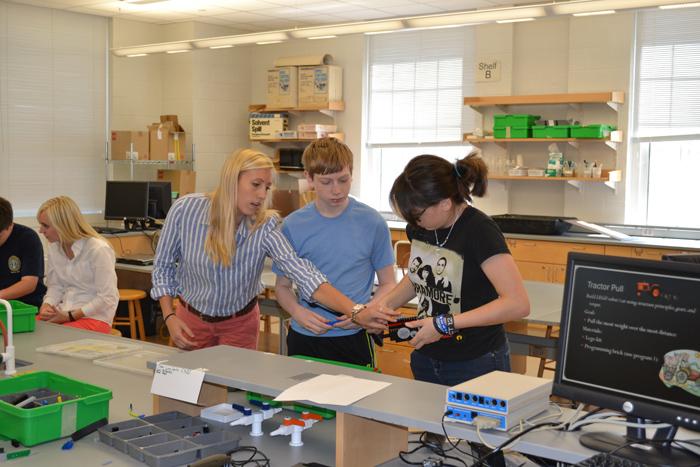Finding Hidden GEMS in the Classroom

For the ninth consecutive summer, elementary, middle and high school students from across the four-state region and beyond are gathering at Hood College in Frederick, Md., to participate in the U.S. Army's Gains in the Education of Mathematics and Science program, sponsored locally by the U.S. Army Medical Research and Materiel Command, Fort Detrick. During the six-week session between June 22 and August 16, the GEMS program offers nearly 400 "student interns" the opportunity to investigate and engage the world of science through four-day courses tailored to the interests of today's youth.
"The best thing about the GEMS program is that it gets students excited about careers in the sciences," said Lauren Beeson, GEMS lab coordinator and head of curriculum development for the Fort Detrick program. "The student interns can choose classes that interest them personally, and all of the work is definitely 'hands-on.' For instance, we offer a biology class where the kids can catch and work with bugs to investigate bacteria using digital microscopes, but we also offer robotics courses that let them build battlebots and mini tractors that they use for challenges and competitions."
Sound fun? Well, having seen the students in action throughout the various classes, fun is definitely part of the equation that has led to the success of the GEMS program over the years.
As part of the Army Educational Outreach Program, which is comprised of Army-sponsored research, education, competitions, internships and practical experiences designed to engage and guide students and teachers in science, technology, engineering and mathematics, or STEM, education, the GEMS program reaches out to young students with the hope of guiding some down the road to science and technology careers.
And this early introduction for the student interns is certainly appreciated by Paige Eckard, who is serving as a first-time near-peer mentor in the program. Eckard, a Virginia Tech junior majoring in Material Science and Engineering, wishes she had attended a program such as this while she was in high school.
"I like the GEMS program because it gives the students a basic introduction to engineering," said Eckard. "It gives kids a good idea of future opportunities in the engineering field, to show them there are many different areas within the field. I didn't even know I wanted to be an engineer until I got to college, so I am glad the kids have this chance to see if they like it."
This year, 11 college-level students are serving as near-peer mentors, helping to provide instruction and guidance in the classroom along with three resource teachers. Prior to the session start, the mentors attend a two-week training course led by subject matter experts from the U.S. Army Medical Research Institute of Infectious Diseases and the U.S. Army Center for Environmental Health Research, both located at Fort Detrick, to ensure that each is well prepared to train and provide a positive impact on the student interns.
Aside from the curriculum designed to engage the students, one must also consider the state-of-the-art facility in which the classes are held. At the center of the Hood College campus sits the Hodson Science and Technology Center, which houses various labs and classrooms equipped with some of the most current technology. Students spend the majority of their day in this building, which certainly isn't a bad thing given its resources.
While touring the classrooms, Beeson led me into an advanced biology class in which 9th- and 10th-graders were conducting "gummi bear dissection."
"We have the students dissect the gummi bears first, before we move on to pig dissection," said Beeson. "But they are allowed to eat some of the gummi bears during the exercise, as an added bonus."
The combination of fun science and gummi bear treats certainly makes for a very enjoyable experience, and it is very clear to see that the students are having a great time while the teachers and mentors slip in a little education, here and there.
Well, perhaps a lot of education.
And best of all, the entire program is free of charge for the students. In fact, students may receive a $100 stipend to offset lunch and transportation costs in order to ensure that boys and girls accepted into the program can attend regardless of economic hardships.
It's clear to see that the USAMRMC Fort Detrick GEMS program is helping our younger generation learn more about the future of, and perhaps their future in, the world of science. Perhaps one day, these children who have been collecting bugs and building robots this summer may grow up to be adults who collect bugs and build robots in one of the many research labs throughout the nation.
And that wouldn't be a bad thing.
-----
The GEMS program is open each year to students in grades 4 through 11, and applications may be submitted online.
For information regarding the program and/or applications for the 2014 summer session, please visit
stem.amedd.army.mil or email
USArmy.Detrick.MEDCOM-USAMRMC.Other.Educational-Outreach@health.mil
to be added to the educational outreach notification list.
or email
USArmy.Detrick.MEDCOM-USAMRMC.Other.Educational-Outreach@health.mil
to be added to the educational outreach notification list.














